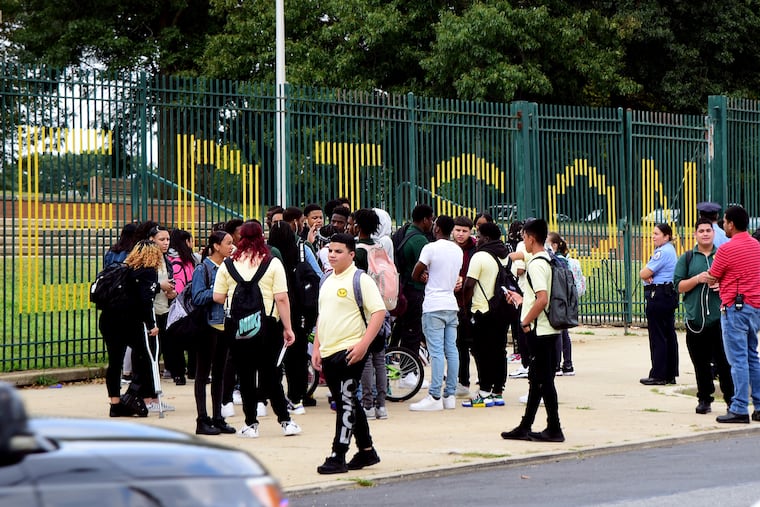City Council members want the Philadelphia School District to release hidden attendance data
Data the district shares with the public makes it appear that a growing number of Philly students are attending school, but classroom-level attendance data reveals that absenteeism may be much higher.

Days after The Inquirer exposed dire truancy problems at a North Philadelphia high school, at least five City Council members are urging Superintendent William R. Hite Jr. to release classroom attendance data that would show an accurate picture of absenteeism for all schools.
The data the district currently shares with the public makes it appear that a growing number of students are attending school — the first step toward improved academic achievement. But those figures don’t always reflect time students spend learning in classrooms.
Records the newspaper obtained for nearly two dozen Thomas A. Edison High School students show they were routinely marked present last school year after they swiped in with their school-issued identification cards at the beginning of the school day — even if they later cut classes, left campus, or walked the halls all day.
The records show one senior was marked present more than 90% of the time despite going to class only 50% of the time. And a freshman who swiped in nearly 100 days stayed for the full school day only 12 times.
Asked about those disparities, chief schools officer Shawn Bird said Edison’s classroom-level attendance data could be inaccurate because teachers have been taking roll improperly and need more training on how to use the district’s software.
“This is an opportunity to look at our systems and see how we’ve trained our staff to take attendance,” Bird said Tuesday.
In June, The Inquirer requested classroom attendance data for all schools. The district has been unwilling to provide it.
Councilwoman Cindy Bass said the district’s refusal to make the data public is as disturbing as the huge disparities between Edison’s swipe and classroom attendance rates.
“Putting some sunshine on a problem like this is critical,” Bass said. “Parents, caregivers, and legislators like myself all deserve to know what’s going on.”
Councilman Allan Domb said he was concerned that students might have been given diplomas even when they were chronically absent. He and Council members Kenyatta Johnson, David Oh and Al Taubenberger also said they want the district to share attendance records with the public.
“If they have nothing to hide, I recommend they disclose,” Domb said.
Ten Edison teachers interviewed over the summer said the school’s hall-walking problem is well known within their ranks. They weren’t surprised to learn that card swipes for a representative sample of their students show they attended 75% of the time while classroom attendance records show the students only went to class 36% of the time.
Council President Darrell L. Clarke called that discrepancy troubling and said he expected the district to address it.
“City Council fully supports public education and has taken significant actions in recent years to raise the necessary local resources to fund our schools,” Clarke said. “But children must be in class, attending school, to get the full benefit of their education.”
The Inquirer filed a Right-to-Know request for classroom attendance data for all Philadelphia schools. The district rejected it, the newspaper appealed, and the Pennsylvania Office of Open Records ruled recently that the district must produce the data, which will not have student names, by early next week.
Bird had no comment on Council members’ calls for transparency. Mayor Jim Kenney and the school board also declined to comment.
Bird did say that it would be “a huge problem” if large numbers of middle and high school students who cut class were being marked present, but said he doesn’t believe that’s the case, despite what The Inquirer’s analysis showed.
“I can tell you from walking in high schools every week that there are not hundreds of kids roaming around the hallways,” Bird said. “Do I see some kids roaming? Of course. But it’s not hundreds of kids.”
At a recent Edison staff meeting, longtime principal Awilda Ortiz discounted the newspaper’s findings, several teachers said. She also blamed the disparity between the school’s swipe and classroom attendance rates on poor record-keeping by teachers, a criticism they dispute.
Jerry Jordan, president of the Philadelphia Federation of Teachers, said attendance issues are serious and citywide. He blamed a surge in hall walking at neighborhood high schools on the district’s 2013 decision to cut funding for nonteaching assistants (NTAs), whose job it had been to monitor the halls.
“It’s not just Edison,” Jordan said. “This is a very big problem.”
» READ MORE: How one Philly high school reveals the district’s dire attendance problems
Councilman Johnson said he also sees a link between class-cutting and staff shortages. The NTAs who worked at Edward W. Bok Technical High School when he was a student there in the early 1990s cared about him and would persuade him to return to class when they found him in the hall, he said.
Johnson called on the district to restore funding for NTAs and modify its attendance policy so that students who swipe in aren’t being marked present when they fail to show up for class. He added that he wants to hold hearings to better understand how truant Edison students could have slipped through the cracks without intervention.
Councilman Derek Green, whose son attends a district school, said: “I drop off my child and assume that he’s going to class. If he doesn’t, that should be communicated to parents. We need to empower and strengthen relationships between families, guardians, and the School District.”